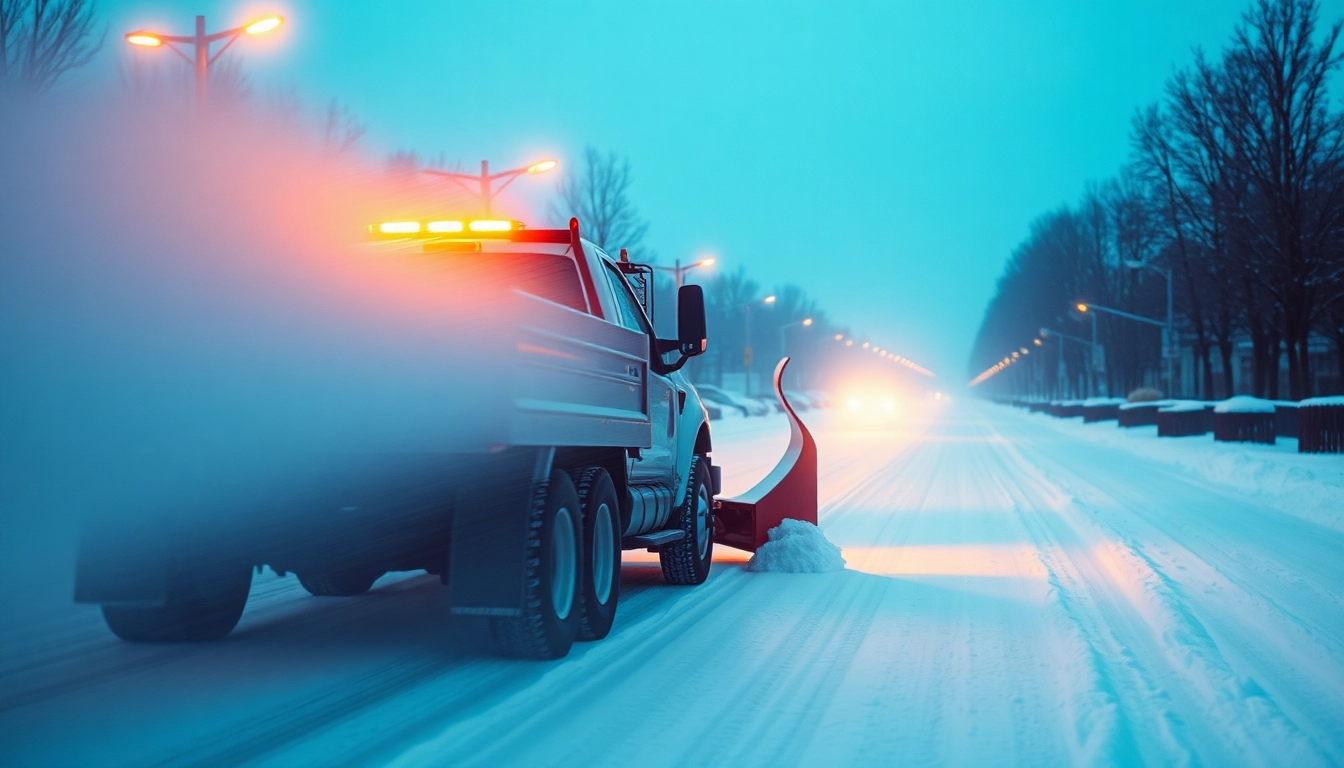Understanding Snow Plowing Basics
What is Snow Plowing?
Snow plowing refers to the process of clearing snow from roadways, driveways, and other surfaces using specialized vehicles fitted with plows. This method is crucial during winter months to ensure safe travel and accessibility. In many regions, snow plowing is performed by local municipalities or private service providers, utilizing trucks equipped with a plow blade attached to the front. These vehicles push the accumulated snow off the roadway or designated area, creating safe pathways for vehicles and pedestrians alike. A snow plowing service can be vital for maintaining normal operations during winter storms.
Importance of Timely Snow Removal
Timely snow removal is crucial for several reasons. First, it enhances safety by reducing the risk of accidents for drivers and pedestrians. Accumulated snow and ice can create hazardous conditions, leading to slips, falls, and vehicular collisions. Second, efficient snow plowing minimizes disruptions in daily life, allowing businesses and schools to operate normally. Lastly, it supports emergency services by ensuring that roads remain clear for ambulances, fire trucks, and police vehicles, which can be critical in urgent situations.
Differences Between Snow Plowing and Snow Removal
While “snow plowing” and “snow removal” are often used interchangeably, they refer to different activities. Snow plowing primarily involves pushing snow from one area to another to clear paths, leaving the snow displaced but still present on the ground. In contrast, snow removal encompasses the act of not just pushing the snow aside but hauling it away entirely from the site. This distinction is critical for property and business owners deciding how best to manage winter weather.
Essential Equipment for Snow Plowing
Types of Snow Plows Available
There are various types of snow plows designed for different applications, each catering to unique needs. Some common types include:
- Straight Blade Plows: These are the most common and feature a straight blade that can be moved left or right. They are effective for clearing snow from roads and parking lots.
- V-Plows: V-shaped plows can push snow to the side more effectively than straight blades and are particularly useful in heavy snowfall conditions.
- Box Plows: Designed for larger areas, these plows scoop snow and are often used in commercial applications, allowing for quick removal of large snow piles.
- Skid Steer and Loader Attachments: For residential or smaller tasks, skid steer attachments can efficiently clear driveways and sidewalks.
Key Features to Look For
When selecting snow plowing equipment, certain features enhance efficiency and safety:
- Durability: High-quality materials ensure the longevity of the plow.
- Adjustable Angles: The ability to change the angle of the blade can assist in directing snow where needed.
- Hydraulic Lifts: These allow for quick changes in height, facilitating cleaning of various surface types and conditions.
- Easy Mounting: A plow that can be easily attached and detached saves time when preparing for seasonal changes.
Maintenance Tips for Snow Plowing Equipment
Regular maintenance of snow plowing equipment is essential to ensure effective operation during winter months.
- Regular Inspections: Check all moving parts, hydraulics, and connections before the snow season starts.
- Lubrication: Keep all joints and moving parts well-lubricated to prevent rust and ensure smooth operation.
- Blade Maintenance: Inspect the plow blade for wear and tear, and replace it if damaged or excessively worn.
- Secure Storage: Store equipment in a dry, sheltered location to prevent damage from moisture and freezing conditions.
Best Practices for Effective Snow Plowing
Preparing Your Property for Snow
Preparation for snow plowing can make a significant difference in the effectiveness of snow management. Some strategies include:
- Removing Obstacles: Clear any debris or obstacles in the snow plowing area such as planters, garbage cans, or lawn ornaments to avoid damage.
- Marking Boundaries: Use markers to indicate the edges of driveways, sidewalks, and landscaping to guide plowing and prevent snow from being inadvertently pushed onto lawns.
- Plan for Snow Storage: Identify safe areas to pile snow, keeping in mind drainage and potential melting issues.
Strategies for Safe Snow Plowing
Safety during snow plowing operations is critical. Effective strategies include:
- Use Low Speeds: Plowing at low speeds allows for better control and reduces the risk of accidents.
- Stay Alert: Keep an eye out for pedestrians and other vehicles in the vicinity when plowing.
- Wear Protective Gear: Ensure that operators use appropriate safety gear, such as non-slip footwear and warm clothing during operations.
Common Mistakes to Avoid During Snow Plowing
Many snow plowing mishaps can be avoided by steering clear of common mistakes:
- Overloading Equipment: Ensure that the snow plow is not overloaded, which can stress the machinery and lead to breakdowns.
- Ignoring Weather Conditions: Adjust plowing strategies based on current weather; heavier snow requires slower speeds and potentially more passes.
- Failing to Communicate: If working with a team, constant communication is essential to ensure everyone is aware of tasks and positions.
Cost Factors in Snow Plowing Services
Understanding Pricing Models
Understanding how snow plowing services price their operations is crucial for budgeting. Providers typically utilize a few different pricing models:
- Per Visit Cost: Many companies charge a flat rate for each visit, which can vary depending on the size of the area and snow conditions.
- Seasonal Contracts: A fixed fee for the entire season can provide savings for homeowners who experience frequent snow.
- Hourly Rates: Some services charge by the hour, which can be beneficial for smaller jobs where time is uncertain.
Evaluating the Cost of DIY vs Professional Services
Homeowners may consider the option of handling snow plowing themselves but must weigh the costs appropriately:
- Equipment Costs: Purchasing a snow plow or specialized equipment can be expensive and requires maintenance.
- Time Investment: DIY plowing demands time and commitment, particularly during heavier snowfalls.
- Safety Risks: Without proper training, there are risks associated with using snow plows, including injury or property damage.
How to Budget for Snow Plowing
Creating a budget for snow plowing involves careful consideration of local climate, the frequency of snow, and property size. Start by estimating the potential cost per visit or for a seasonal contract. Then, factor in any additional costs that might arise from heavy snow periods, equipment breakdowns, or potential damage to property that could necessitate emergency services. Always have a small contingency built into your budget for unexpected expenses.
Finding Reliable Snow Plowing Services
Evaluating Local Snow Plowing Providers
When looking for reliable snow plowing services, consider the following evaluation processes:
- Research Local Options: Start by querying local service providers and checking for their credentials and experience levels.
- Ask for Recommendations: Friends, family, or neighborhood online groups can provide invaluable insights into reputable providers.
- Check Availability: Ensure that the provider can accommodate your needs, especially during peak snow months.
Customer Reviews and Ratings
Customer feedback helps gauge the reliability and effectiveness of snow plowing services. Look for:
- Online Reviews: Websites such as Yelp and Angie’s List often feature comprehensive ratings and reviews from previous customers.
- Social Media Feedback: Local community groups on platforms like Facebook can also share positive or negative experiences with local providers.
- Business Ratings: Check the Better Business Bureau for any complaints or resolutions related to snow plowing services.
Questions to Ask Before Hiring
Before hiring a snow plowing service, it’s crucial to ask the right questions:
- What are your pricing structures? Understanding how they charge helps set clear expectations.
- What equipment do you use? Ensure their equipment is reliable and well-maintained.
- Do you have insurance? Verify that they have adequate insurance to protect against damages and liabilities.
- What are your service hours? Knowing their availability can prevent issues during snow emergencies.



